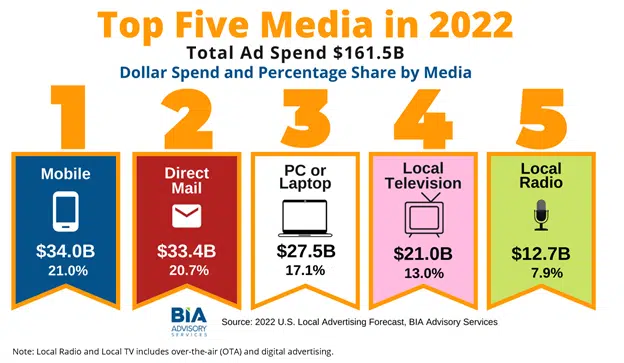Why we care about location marketing
Location-based marketing is effective for brands with physical locations. Here’s how to leverage the strategy.
What if you could tailor marketing messages at the granular level, based on where your consumers are, in real time?
For example, what if you could send a discount offer on a product or service by text message when a customer enters a pre-defined location, such as your brick-and-mortar store? Or remind your customers that it’s happy hour — and that you offer two-for-one appetizer specials — when they’re near your bar or restaurant.
Delivering offers to target customers is the key benefit of location-based marketing.
The means to deliver location-based marketing is in place and familiar. Mobile phones are ubiquitous, providing the device necessary to deliver messages to consumers wherever they are. And, consumers expect to receive ads and offers on those mobile devices. Advertising on mobile devices captured the largest share of digital advertising in 2022 at $34 billion. (Overall, spend on digital marketing was a staggering $77 billion.)

In this article, you’ll learn the importance of leveraging data from users’ mobile devices to create ads, offers and other content that drives business.
We’ll define location marketing and describe several location-based marketing methods.
Table of contents
- What is location-based marketing?
- Location-based marketing targeting methods
- The benefits of location-based marketing
- Challenges of location-based marketing
- Additional resources
Estimated reading time: 5 minutes
What is location-based marketing?
Location-based marketing (or “proximity marketing”) delivers ads and offers to potential buyers based on their location. There are two ways to identify the locations of potential buyers:
- By GPS coordinates on a mobile device.
- By deploying Bluetooth-based “beacon” technology to trigger ads or alerts when consumers are in places (i.e., stores) that GPS signals can’t always reach.
The major difference here lies in how location data is generated. (Beacons transmit information very short distances. They are used within locations like store aisles.)
Relevance is a key benefit of location marketing. Instead of pushing generic ads across channels and hoping that some of it resonates, location-based marketing lets marketers to deliver highly targeted messages that reach consumers as they go about their daily activities.
Location-based marketing works best for brands or businesses with retail locations. For example, a furniture store might send Presidents’ Day discount notifications to customers who have pulled into the parking lot of the mall in which the store is located during the holiday weekend.
It’s worth mentioning another important type of location-based marketing that is inbound and doesn’t depend on mobile data. Sites like Yelp will show advertisements and promotions based on user behavior, including the locations and types of businesses explored on the site.
Location-based marketing targeting methods
There are three primary methods of location-based marketing, which target customers based on where they are, where they have been and where brands would prefer them to be.
Geofencing: Reach them where they are
Geofencing uses a variety of location services to pinpoint where consumers are in real time and is deployed by software that is contained within mobile apps. Geofencing is enabled only when customers share their locations from within an app.
The geographic area has boundaries, hence the term “fencing.” An example would be a radius around a store, restaurant, neighborhood, etc. When people enter or exit the boundary, messages are delivered.
Starbucks uses geofencing to send rewards program members discounts on drinks they regularly order when those customers are near cafes.
Geotargeting: Reach them where they’ve been
Geotargeting relies on reaching people based on where they’ve been and what actions they might have taken when they were there.
Geotargeging enables marketers to send targeted content to specific groups or those who have engaged in specific behaviors.
A restaurant may want to promote a new brunch menu, for example. It might build a campaign for customers who have visited recently to drive return business.
Geoconquesting: Get them to go somewhere else
Geoconquesting delivers notifications to customers when they are near a competitor’s business.
In one well-known example, Burger King created a campaign called the “Whopper Detour” to target consumers within 600 feet of McDonald’s locations.
This clever — and popular — marketing strategy used geofencing to send coupons for one-cent Whopper sandwiches to users of the BK app, which was reportedly downloaded a million times over the course of a couple days during the campaign.
The benefits of location-based marketing
For marketers, there are many reasons to implement location-based strategies.
By delivering ads, offers and information when potential buyers are near the point-of-purchase, merchants can increase foot traffic and improve customer experience, which in turn helps boost customer retention and loyalty.
Location-based marketing also offers a window into what customers want using insights gleaned from what they spend their time doing and how much time they spend doing it.
Attribution of location-based marketing tactics tends to be higher than other channels. Measures of sales, in-store traffic, and engagement are more accurate because customers are using trackable mobile devices and apps.
Challenges of location-based marketing
Location-based marketing is not without challenges.
This channel relies on marketers getting data only from mobile users who have opted in to location tracking and have downloaded the brand’s app.
Privacy is also a concern. Advertisers need to strike a balance between sending ads and offers when they will be viewed as beneficial to users, while avoiding the perception that location-based marketing is overly intrusive or creepy.
Dig deeper
Want to learn more? Here are some other great resources:
- Check out MarTech’s location marketing content page.
- Mobile app experience developer Airship has some real-world examples here.
- Read HubSpot’s guide to local marketing.
- And here’s Yelp’s perspective on local marketing for businesses.
Opinions expressed in this article are those of the guest author and not necessarily MarTech. Staff authors are listed here.
Related stories